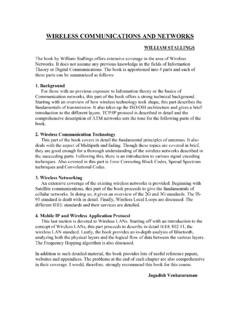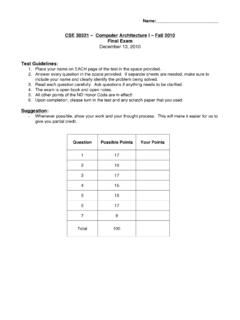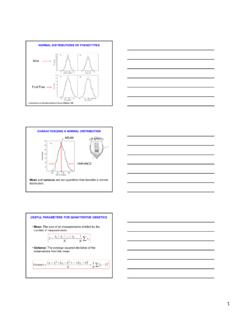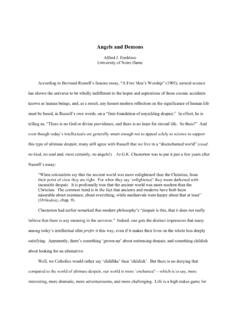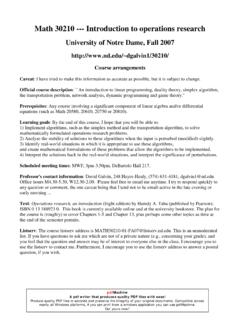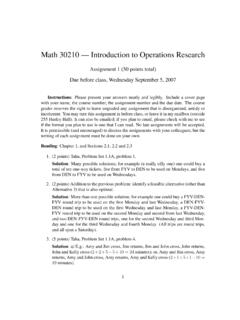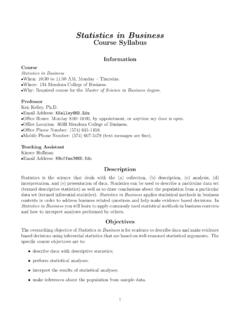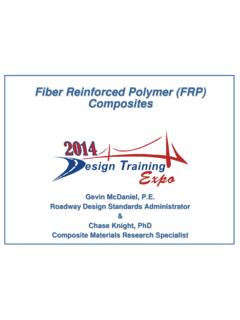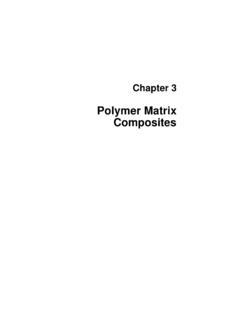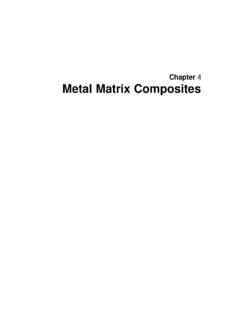Transcription of CHAPTERS 14/15: POLYMER STRUCTURES, APPLICATIONS, & …
1 ISSUES TO What are the basic microstructural features? How do these features dictate room T tensile response? Hardening, anisotropy, and annealing in polymers. How does the mechanical response compare between ceramics and metals at elevated temperatures? CHAPTERS 14/15: POLYMER STRUCTURES, APPLICATIONS, & PROCESSING POLYMERS Synthetic fabrics are man-made copies of natural fabrics (Velcro). Typical plastic extrusion products. Liquid crystals are also polymers. Polymers are materials comprised of long molecular chains. Most polymers are carbon based and have relatively low melting points. The principle of operation of a LCD POLYMERS A POLYMER is a macromolecule (long molecules) built of small covalently bonded units called monomers ( mer from the Greek word meros meaning part).
2 These small units are repeated throughout the macromolecule chain. The macromolecules are bonded together by weak Van der Waals and hydrogen (secondary) bonds, or additional covalent cross-links. POLYMER = many mers Covalent chain configurations and strength: Direction of increasing strength POLMER MICROSTRUCTURE The Polymers: Classification The main classes of polymers are: Natural polymers Example: cellulose and protein, which provide the mechanical basis for most plant and animal life Thermoplastics, which soften on heating Example: polyethylene Thermosets or Resins, which harden when two components are heated together Example: an epoxy Elastomers or Rubbers Natural Polymers Polymers may be natural, such as cellulose, DNA, caoutchouc (India rubber).
3 Living organisms are mainly composed of polymerized amino acids (proteins) nucleic acids (RNA and DNA), and other biopolymers. The most powerful computers -our brains - are mostly just a complex POLYMER material soaking in salty water! Silk fiber is produced by silk worms in a cocoon, to protect the silk-worm while it metamorphoses into a moth Framework of all plant life, as the main structure in cell wall The other main component in cell walls Gelatin, wool, silk Generic Thermoplastics Thermoplastics are made by adding together, polymerizing , sub-units (monomers) to form long chain. Many of them are made of the unit: repeated many times. The radical R may be hydrogen (PE) or CH3 (PP) or Cl (PVC) or more complicated (as for nylon) Generic Elastomers (Rubbers) Rubbers are almost-linear polymers with occasional cross-linked in which at room temperature the secondary bonds have already melted.
4 However the cross-linked provide memory of the material so that it returns to its original shape on unloading. The common rubbers are all based on a single structure: with the position R occupied by H, CH3 or Cl. Generic Resins Epoxy: an adhesive and a matrix for different composites is a thermoset. Thermosets are made by mixing of two components (a resin and a harder) which react and harden, either at room temperature or on heating The resulting polymers is usually heavily cross-linked: network POLYMER !! The cross-links form during the polymerization of the liquid resin and hardener so the structure is almost amorphous. POLYMER Characteristics THE STRUCTURE of POLYMERS: Hydrocarbon Molecules Most polymers are organic, and formed from hydrocarbon molecules Each C atom has four e- that participate in bonds, each H atom has one bonding e- Attachment of different organic groups to the hydrocarbon backbone offers wide variety of possible polymers Examples of saturated (all bonds are single ones) hydrocarbon molecules (of type CnH2n+2) Compositions and Molecular Structures for some CnH 2n+2 Compounds Boiling Points rise Unsaturated Bonds Double and triple bonds can exist between C atoms (sharing of two or three electron pairs).
5 These bonds are called unsaturated bonds. Unsaturated molecules are more reactive ISOMERS Isomers are molecules that contain the same atoms but in a different arrangement. An example is butane and isobutane: The Polymers Chemistry: Ethylene Polyethylene Polymerization: the reaction of the monomers to form the POLYMER macromolecule (a) The initial monomer (R); (b) Under certain conditions (T, P) in the presence of catalyst the double bonds break: forming a highly reactive radical with an unpaired electron, ready for the linking (polymerization) (d-f) the ethylene POLYMER (polyethylene) chain is limited by the addition of terminators ( OH group). Molecular Weight (1) To create a solid with useful mechanical properties the chain must be long !! One may describe chain length in terms of POLYMER average molecular weight, which can be defined in several ways: (1) A number-average molecular weight Mn : divide chains into series of size ranges and then determine the number fraction xi of each size range where Mi represents the mean molecular weight of the size range i, and xi is the fraction of total number of chains within the corresponding size range Molecular Weight (2) (2) A weight average molecular weight Mw is based on the weight fraction wi within the size ranges: Typical distribution of molecular weight Molecular Weight Calculation Example.
6 Average mass of a class Student Weight mass (lb) 1 104 2 116 3 140 4 143 5 180 6 182 7 191 8 220 9 225 10 380 What is the average weight of the students in this class: a)Based on the number fraction of students in each mass range? b)Based on the weight fraction of students in each mass range? Molecular Weight Calculation (cont.) Solution: The first step is to sort the students into weight ranges. Using 40 lb ranges gives the following table: weightnumber ofmeannumberweightrangestudentsweightfra ctionfractionNiWixiwimass (lb)mass (lb) number total weight Calculate the number and weight fraction of students in each weight range as follows: For example: for the 81-120 lb range Molecular Weight Calculation (cont.) weightmeannumberweightrangeweightfractio nfractionWixiwimass (lb)mass (lb) of Polymerization (1) The chain length in a POLYMER can also be described in terms of a degree polymerization n, which represents an average number of mer units in a chain Again two approaches are possible: Number average nn: Weight-average nw: where m is a mer molecular weight if the POLYMER is built up of different mer units (copolymer) m is determined from : where fj and mj are the chain fraction and molecular weight for mer j.
7 Degree of Polymerization (2) Average DP is simply: 0)DP(d)DP(PDPDP where P(DP)d(DP) is the fraction of molecules with DP values between DP and DP+d(DP). And the molecular weight, M, is just M=m DP where m is the molecular weight of monomer POLYMER properties depend on average DP. Example: higher DP higher tensile strength and melting point!! Question: how one can control DP ?! MOLECULAR ARCHITECTURE A molecule with one active bond can act as chain terminator but cannot form a link in a chain Example: -OH Monomers which form linear chain have two active bonds they are bifunctional. Example: thermoplastics have linear not cross-linked molecules (polyethylene) Monomers with three or more active sites (polyfunctional) form network. Example: thermosetting polymers Molecular Structure (a) Linear POLYMER : end-to-end joining of mers, single, long flexible chains, van-der-Waals and hydrogen bonds hold chains together (polyethylene etc.)
8 (b) Branched POLYMER : side branch chains connected to main chain, reduced chain packing capability and therefore density (c) Cross-Linked Polymers: adjacent chains joined by side chains; synthesis at elevated temperatures promotes cross-linking; non-carbon atoms might be involved in cross-linking bond ( sulfur in vulcanization, rubber) (b) Network-Polymers: highly cross-linked, tri-functional mers can provide three dimensional cross-linking (epoxy resins, phenyl-formaldehyde) Stereoisomerism: thermoplastics Polyethylene is the simplest linear chain. By replacing one H atom with a side-group or radical R a vinyl group of polymers Example: R=Cl (Polyvinyl chloride) or R=CH3 (polypropylene) R gives asymmetry to the repeating units that causes more than one way in which they can be linked to form a chain stereoisomerism.
9 Transformation from one in to the other isomer is not possible by bond rotation. isotactic configuration: all R-groups are situated on the same side of the chain syndiotactic configuration: R-groups are situated on alternate sides of the chain atactic configuration: R-groups are arranged in a random position Geometrical Isomers: rubbers Consider a carbon-carbon double bond in rubbers, which cannot rotate freely without breaking a covalent bond, the R group or side-atom can be positioned on the same side (cis) or on opposite sides (trans). cis-polyisoprene (natural rubber) H and CH3 group on the same side, the other bonds are along the chain trans-polyisoprene properties differ markedly from natural rubber ( gutta percha ) Copolymers Copolymers consist of two or more different mer units.
10 An idea is similar to this for composites: obtain new POLYMER properties by combination!! Depending on the polymerization process and relative fraction of mer types different arrangements are possible. random alternating block graft Example: Styrene-butadiene rubber is a common synthetic copolymer For automobile tires + = SBR Styrene Butadiene Molecular Shape The rotational degree of freedom in the bonds of the POLYMER chain backbone allows a wide range of molecular shapes for the chain. One example in nature is the folding of proteins which influences the functionality of the whole structure. l n steps r =(l)1/2n Because chain-links bend in a random way the average distance, r, between start and end of the chain calculated in the same way as the distance a drunk staggers from the pub (a random walk ) POLYMER Crystallinity Packing of the molecular chains so as to produce an ordered atomic array Molecular weight, Mw: Mass of a mole of chains.
